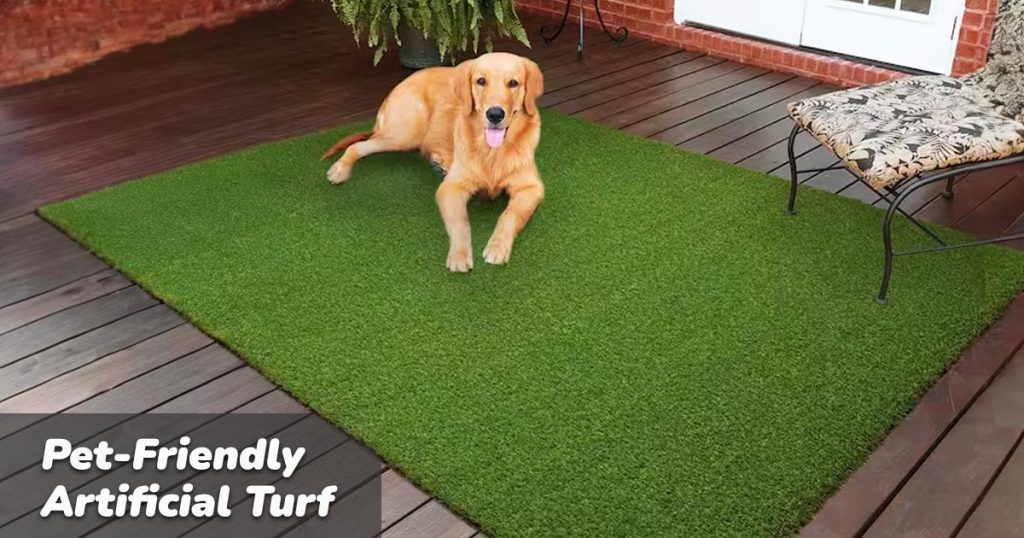Looking for a hassle-free lawn for your furry friend? Artificial grass might be the solution since it’s safe for dogs. It’s durable, pet-friendly, and could save you time and cash. Learn about the pros and cons of artificial grass with dogs, and you might switch to synthetic turf for your pet’s playtime.
Pros of Artificial Grass for Dogs
Is artificial turf good for dogs? Let’s explore the perks for pet owners and their furry friends when it comes to laying down artificial grass.
No more pests
Say goodbye to fleas and ticks invading your home with artificial grass. It promotes your pet’s well-being by preventing issues like itching, skin irritation, hair loss, and scabs. Plus, you can breathe easy knowing your pet won’t fall seriously ill from tapeworm or anemia caused by these pests.
With synthetic grass, you won’t have unwanted wildlife visitors like deer or rabbits munching on your lawn. And pesky bugs that damage natural grass won’t be a concern since there’s nothing for them to munch on. Thanks to drainage holes, water doesn’t collect, eliminating standing water that attracts insects.
Forever green
Fed up with unsightly brown or yellow patches on your grass? It’s likely caused by dog pee, which contains lots of nitrogen and salt that harm natural lawns. But with artificial turf, there’s no need to fret about stains from your furry friend’s bathroom breaks. Synthetic grass stays green and pristine, no matter how often your pet does its business.
Free from allergens
If grass allergies are a concern for you or your dog, pet-friendly turf might be the solution. Artificial grass and dogs go well together if natural grass triggers your pet’s scratching, hair loss, and rashes because they are allergic or sensitive to it. Synthetic turf offers a beautiful green lawn without putting your dog’s health at risk.
Easy to cleanup
For pet owners thinking about getting artificial lawns, the smell can be a worry. Dealing with pet waste daily means dealing with odors. But synthetic grass comes with solutions like turf deodorizers and liquid cleaners to tackle the smell.
Whether you have real grass or synthetic turf, it’s important to clean up after your dog promptly. Leaving waste too long can lead to health issues. For artificial lawns, rinse the area several times, use a mixture of vinegar and water, and clear away any debris with a leaf blower. Finally, give the artificial lawn a good hose down with water.
Less mess inside
Dogs don’t just carry fleas inside; they also bring in dirt with muddy paws and messy fur from real grass. Cleaning up can be a hassle, especially if you have carpet throughout your home. With artificial grass, there are no bare spots for rain to create muddy messes for your pets. Plus, fake grass won’t stick to your dog’s fur when they romp and roll around.
Cons of Artificial Grass for Dogs
Let’s get down to the disadvantages of artificial grass for your dogs:
Needs replacement
Replacing artificial turf costs more than replacing natural grass, and the frequency of replacement varies. Turf used on sports fields needs more frequent replacement due to heavy use compared to residential yards.
Under normal use, a well-maintained artificial lawn can last 15 to 20 years. Despite continuous improvements in durability and appearance, improper cleaning of pet waste can shorten its lifespan due to buildup on the grass blades.
Maintaining natural grass by overseeing it annually is cheaper. This practice keeps it green, thickens the lawn, and extends its lifespan at minimal cost.
High costs
There’s no avoiding it: installing artificial turf costs more upfront compared to natural grass. On average, synthetic turf installation runs over $12 per square foot, totaling around $5,000 for an average lawn. In contrast, even the priciest sod averages just 83 cents per square foot.
When laying natural grass, you might need to buy or rent equipment like a sod cutter and rototiller, which can add up. Installing artificial grass requires similar equipment plus additional materials like infill, weed barriers, edging, adhesives, and the turf itself.
However, the long-term costs may balance out, as maintaining real grass tends to be more expensive than artificial turf. Ultimately, you’ll need to weigh whether the lower maintenance of fake grass in the future is worth the initial investment.
Heats up
Artificial grass can become too hot for our pets’ paws, especially on sunny days. Since dogs naturally have higher body temperatures, around 101 degrees Fahrenheit, exposing them to hot surfaces can cause dehydration or heat stroke.
Unlike natural grass, which releases water vapor and cools the area, fake grass can’t do the same and instead absorbs heat. Studies show that synthetic turf can get at least 20 degrees hotter than real grass, although most research focuses on sports fields.
To keep your furry friend comfortable, limit outdoor playtime on artificial turf to mornings and evenings when it’s cooler. Ensure your pet has access to shade during the hottest parts of the day, and consider bringing them indoors to avoid overheating.
Bad odor
You can’t count on rain to wash away pet waste from artificial turf. As mentioned earlier, picking up poop right after your dog does its business prevents it from sticking to the fake grass. It’s also crucial to address pet urine promptly.
When dogs pee on fake grass, it seeps through the blades and collects at the bottom. If not cleaned, it can create a lingering odor. Regularly hosing down your artificial turf helps remove both the urine and the smell.
Using Artificial Grass for Your Pets
Consider the benefits and drawbacks outlined above when deciding whether artificial grass is the right choice for your furry friend. Evaluate factors like cost, maintenance, and pet safety to make an informed decision. Whether you opt for synthetic or natural grass, prioritize your pet’s well-being and comfort.

